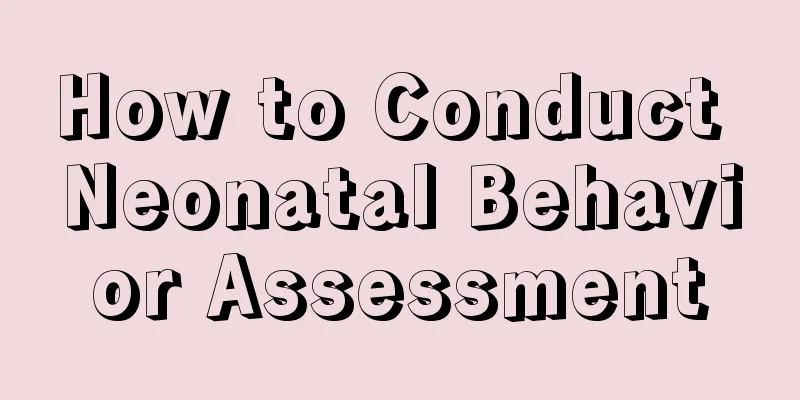How to Conduct Neonatal Behavior Assessment

|
When newborns reach a certain age, they must go to the hospital for neonatal behavioral assessment. Many mothers of newborns do not know what neonatal behavioral assessment is, nor do they know how neonatal behavior is measured. Now let the editor analyze how neonatal behavior is measured, so that parents of newborns can be mentally prepared and have a general understanding, so that they will not be in a hurry when the time comes. The behavioral abilities of newborns are mainly manifested in seeing, hearing, smelling, reaction ability, neural reflexes and interaction with adults. The editor has summarized the following knowledge about how to test the behavioral abilities of newborns, hoping to help friends. Vision When awake, normal newborns can look at objects and follow the direction in which they move. They are particularly interested in brightly colored objects. For example, if a red balloon is hung above his head, he will follow the direction of the balloon's movement with his eyes, and sometimes he will stare intently at a certain object. Newborns are also sensitive to light and will close their eyes when exposed to strong light. Hearing When a newborn is born, its hearing is slightly poor due to the lack of air in the ear's tympanic cavity and the retention of amniotic fluid. Its hearing will be very good 3 to 7 days after birth. If you call softly in his ear, the little guy will turn his head in the direction of the sound. Sometimes they use their eyes to find the source of the sound. If the noise is too loud, the little one will cry to express his protest. Taste and smell When a newborn is born, his sense of taste and smell are already basically fully developed, and he reacts differently to different smells, so it is not easy to deceive him. If you feed him sugar water, he will accept it with pleasure, but if you put berberine in his mouth, he will show his resistance by grinning or spitting it out. Newborns are sensitive to the scent of breast milk. When they smell the milk during breastfeeding, they will bury their heads in their mother's arms and look for the mother's nipple. Some little ones can even distinguish the different smells of their own mothers from those of other wet nurses. Skin sensation Newborns have a very sensitive sense of touch, especially in the eyes, mouth, palms, soles of feet and other parts. They will react when touched, such as blinking, opening mouth, and retracting hands and feet. If you place your hands on a crying newborn's belly or gently hold his hands, you can often help him calm down slowly. sports The movements of newborns are mostly unconscious and uncoordinated. When a newborn baby who is almost one month old is picked up, his head can maintain an upright position for a very short time. If he is held upright so that his feet touch the bed, one of his legs will straighten and the other will be lifted. When you put your finger or toy in his little palm, he will hold it tightly and refuse to let go easily. Neurological reflexes Newborns are born with some innate reflexes, and parents can try to check whether their children have these reflexes. First, you can touch the baby's cheek gently with your fingers. Under normal circumstances, he will reflexively turn his head to the touched side. If you touch his lips, he will purse his lips like a bird foraging for food. This is called the foraging reflex. You can also gently pull up his hands when the baby is lying on his back, slowly raise his body, and suddenly let go when his shoulders are slightly off the bed. A normal newborn will have his arms abducted, straightened, and then adducted and flexed towards the chest, similar to the action of hugging. This is the hugging reflex. Of course, the examination should be gentle, and you must not scare the baby, and be careful not to hurt the child; there is also a crossed leg reflex, which you might as well try. You can press one of the child's knee joints with one hand and stroke the sole of the foot on that side with the other hand. Then you can see his lower limb on the opposite side retract, straighten, and then adduct, touching the stimulated lower limb or crossing it. These neural reflexes are temporary reflexes in the neonatal period. Under normal circumstances, they disappear naturally 3 to 4 months after birth. If your baby does not show these reflexes in the neonatal period, or the reflexes do not disappear 3 to 4 months after birth, you should go to the hospital and ask a doctor to help check it out. Interactive capabilities Newborns are born with the ability to interact with the environment and with adults. He will follow the adults' talking or smiling faces, and he will cry to attract the adults' attention so that his demands can be met. Through the above introduction, do you have a certain understanding of how to conduct neonatal behavior measurement? If you find that the neonatal behavior measurement is not standard during the examination, don’t panic. Observe for a period of time. If there is no improvement, you should take your baby to the hospital for examination in time. |
>>: Why does my child always wake up in the middle of the night?
Recommend
What to do if your child has difficulty breathing
Children are not like us adults and do not know h...
What to do if your seven-month-old baby has a dry cough
Babies have a relatively weak constitution, so th...
Two week old baby crying at night
A two-week-old baby is very small, and his physic...
How tall is a baby at 3 months old?
The health of babies is very important. Their dev...
How to treat abscesses on children's gums?
During the growth and development period of child...
What to do if your 50-day-old baby has a stuffy nose
Babies who are about 50 days old are already one ...
What to do if your child has white ringworm on his face
I believe that many people will feel very worried...
How to treat tooth decay in children
Teeth are very important to us, and tooth protect...
Pathology of juvenile rheumatoid arthritis
Juvenile rheumatoid arthritis is a very harmful d...
What should I do if my child's heart is not well developed?
The heart is a blood transport organ. Its importa...
What toothbrush should I use for a 1.5 year old baby?
Some parents pay great attention to oral hygiene,...
How to treat peeling of the fingertips in children
The growth of a child affects the hearts of many ...
Emergency treatment for children vomiting in the middle of the night
Many parents are particularly worried about their...
How often should you change your baby's diapers?
Babies do not have the independent awareness of u...
What to do if your child has a severe cough
Children's cough is a common disease that occ...









